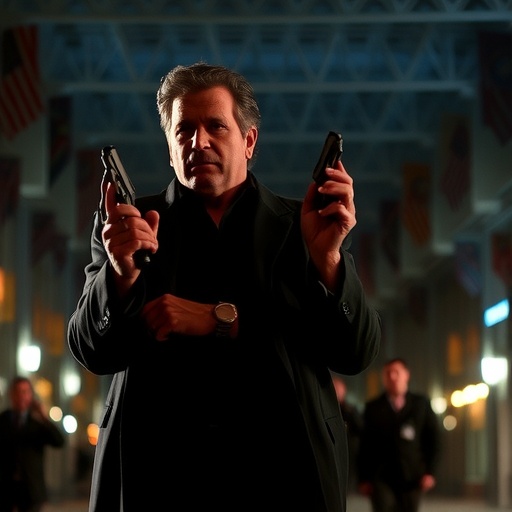Michael Mann’s ‘Heat 2‘ Lands Massive $37.2 Million Tax Incentive to Revive Los Angeles Filming Boom
In a blockbuster move that’s set to ignite Hollywood’s engines once again, acclaimed director Michael Mann’s highly anticipated sequel Heat 2 has secured a staggering $37.2 million tax incentive from the California Film Commission. This financial lifeline not only promises to bring the gripping crime saga back to the streets of Los Angeles but also underscores a pivotal push to reclaim the city’s status as the world’s entertainment capital amid fierce competition from rival production hubs.
- Dissecting the $37.2 Million Tax Incentive Package for Heat 2
- Michael Mann’s Vision: Bringing Heat 2 Back to LA’s Mean Streets
- California’s Tax Incentive Revival: How Heat 2 Fits into the Bigger Picture
- Economic Ripple Effects: Jobs, Tourism, and Hollywood’s Renaissance
- Looking Ahead: Heat 2’s Release and the Future of LA Cinema
The announcement, made earlier this week, comes at a critical juncture for California’s film industry, which has been hemorrhaging jobs and projects to states like Georgia and New Mexico offering more generous incentives. For Mann, the Oscar-nominated visionary behind the 1995 classic Heat, this tax incentive represents more than just funding—it’s a green light to expand his cinematic universe with the same gritty authenticity that made the original a timeless thriller.
Heat 2, based on the novel co-authored by Mann and Meg Gardiner, picks up the narrative threads from the original, delving deeper into the cat-and-mouse game between detective Vincent Hanna (Al Pacino’s iconic role) and master thief Neil McCauley (Robert De Niro). With production slated to commence in Los Angeles later this year, the project is expected to generate hundreds of local jobs, inject millions into the economy, and showcase the city’s diverse locations from downtown skyscrapers to sun-drenched freeways.
Dissecting the $37.2 Million Tax Incentive Package for Heat 2
The $37.2 million tax incentive for Heat 2 is part of California’s revamped Film and Television Tax Credit Program, which allocates up to $330 million annually to qualifying productions. This specific award, representing about 11% of the film’s estimated $250 million budget, covers a range of rebates including sales and use taxes, income taxes, and credits for below-the-line workers. According to California Film Commission Executive Director Amy Lemisch, “This incentive isn’t just about dollars—it’s about dollars staying in California, supporting families and businesses that make our state the creative heart of the world.”
To qualify, Heat 2 had to meet stringent criteria: at least 80% of principal photography in the state, with a focus on Los Angeles County. The production’s commitment to hiring local crew members—projected at over 1,200 jobs—and sourcing vendors from within California tipped the scales. Michael Mann, known for his meticulous preparation, has already scouted iconic LA spots like the Bradbury Building and the Los Angeles River, echoing the original film’s visceral urban backdrop.
Breaking down the numbers further, the incentive breaks into key components: $25 million in transferable tax credits that Warner Bros., the studio backing the film, can sell to offset corporate taxes; $8 million in direct rebates for qualified expenditures; and $4.2 million earmarked for workforce development programs. This structure ensures that the benefits ripple beyond the studio lot, funding training for aspiring filmmakers and bolstering under-represented communities in the industry.
Experts note that this deal is among the largest single-project incentives since the program’s expansion in 2020. Film economist Patrick Janz from the University of Southern California estimates that for every dollar of tax credit, the state recoups $1.50 in economic activity through spending on hotels, catering, equipment rentals, and more. “Heat 2‘s incentive is a smart investment,” Janz said in an interview. “It not only brings prestige but also stabilizes an industry that’s lost over 20% of its productions to out-of-state competitors since 2015.”
Michael Mann’s Vision: Bringing Heat 2 Back to LA’s Mean Streets
Michael Mann, the 81-year-old auteur whose career spans from Thief to Collateral, has long been synonymous with Los Angeles as a character in his films. The original Heat captured the city’s nocturnal pulse, turning everyday locales into pressure cookers of tension. Now, with Heat 2, Mann aims to do the same, leveraging the tax incentive to film on location rather than relying on green screens or overseas sets.
In a rare statement to Variety, Mann emphasized the importance of authenticity: “Los Angeles isn’t just a setting for Heat 2; it’s the soul of the story. The tax incentive allows us to capture the city’s evolution—the new skyscrapers, the changing neighborhoods—while honoring the raw energy that defined the first film.” The sequel’s plot spans timelines, exploring prequels and sequels to the 1995 showdown, with Mann directing from a script he co-wrote. Casting rumors swirl around returning stars like Val Kilmer and potential newcomers, but Mann has kept details under wraps, building anticipation.
Production details reveal a commitment to scale: Heat 2 will utilize cutting-edge IMAX cameras, much like Mann’s recent Ferrari, to immerse audiences in high-stakes heists and pursuits. The tax incentive facilitates this ambition by reducing costs on practical effects, stunts, and location permits. Los Angeles Mayor Karen Bass praised the project, stating, “Heat 2 will spotlight our city’s resilience and diversity, drawing tourists and talent back to Hollywood while creating real opportunities for Angelenos.”
Behind the scenes, Mann’s team has collaborated with the Los Angeles Police Department for accurate depictions of tactical operations, ensuring the film’s procedural realism. This level of detail, funded in part by the incentive, positions Heat 2 as a potential awards contender, blending Mann’s signature style—neon-lit nights, philosophical monologues, and explosive action—with contemporary relevance.
California’s Tax Incentive Revival: How Heat 2 Fits into the Bigger Picture
The $37.2 million tax incentive for Heat 2 is a cornerstone of Governor Gavin Newsom’s aggressive strategy to revitalize California’s film sector, which contributes $30 billion annually to the economy and supports 700,000 jobs. Since the program’s inception in 2009, it has lured back over 100 major productions, but recent expansions have doubled the budget to combat ‘runaway production’—a phenomenon where films like The Mandalorian decamp to Georgia for up to 30% tax breaks.
California’s program now offers up to 35% credits for visual effects and music scoring, with additional bonuses for diverse hiring and sustainable practices. For Heat 2, this meant incentives for employing women and minorities in key roles, aligning with Mann’s inclusive approach. Data from the California Film Commission shows that incentivized projects generated $26 billion in economic output from 2019 to 2023, including $2.5 billion in wages.
Yet, challenges persist. Critics argue the program disproportionately benefits big studios, with independent filmmakers receiving only 15% of credits. The Motion Picture Association counters that blockbusters like Heat 2 act as multipliers, spawning spin-offs and tourism. A 2023 study by the Milken Institute found that for every 1,000 jobs created by a film like this, ancillary industries see 2,500 more opportunities in construction, retail, and hospitality.
Looking at peers, Heat 2‘s deal dwarfs smaller incentives like the $15 million for Book of Lions but aligns with tentpoles such as Avatar: Fire and Ash‘s $40 million award. This tiered system ensures high-profile projects anchor the ecosystem, drawing infrastructure investments. As one producer noted anonymously, “Michael Mann’s involvement elevates Heat 2 from a sequel to a statement—proving LA can still compete globally.”
Economic Ripple Effects: Jobs, Tourism, and Hollywood’s Renaissance
Beyond the headlines, the tax incentive for Heat 2 promises tangible boosts to Los Angeles’ economy. Projections indicate the production will spend $200 million locally over 120 shooting days, covering everything from craft services to helicopter rentals. The Los Angeles Economic Development Corporation forecasts 1,500 direct jobs, including grips, electricians, and makeup artists, plus 3,000 indirect roles in supporting sectors.
Historically, films like the original Heat have left lasting legacies: the coffee shop scene alone became a tourist draw, contributing to LA’s $1.2 billion annual film tourism revenue. Heat 2 could amplify this, with Mann planning sequences in emerging areas like the Arts District and Boyle Heights, promoting cultural revitalization. “We’re not just filming; we’re investing in communities,” said a spokesperson for the production.
Union leaders from IATSE and Teamsters hail the incentive as a lifeline post-COVID, when the industry lost 40% of its workforce. With inflation squeezing budgets, the credits ensure competitive wages—averaging $75,000 per crew member. Environmentally, Heat 2 commits to green practices, like electric vehicles for transport, earning bonus credits and appealing to eco-conscious audiences.
On a broader scale, this deal signals Hollywood’s rebound. Amid strikes and streaming wars, Heat 2 represents theatrical ambition, potentially grossing over $500 million worldwide. Analysts predict it could inspire a wave of location-based shoots, reversing the 25% decline in LA permits since 2019.
Looking Ahead: Heat 2’s Release and the Future of LA Cinema
As Heat 2 gears up for a 2025 release, the tax incentive’s impact will unfold in real time. Pre-production milestones include set construction starting next month and casting calls opening to locals, fostering talent pipelines. Michael Mann has teased international shoots in Mexico for authenticity, but the core remains LA-centric, thanks to the funding.
Industry watchers anticipate ripple effects: more incentives could follow for sequels like Top Gun 3, solidifying California’s edge. Newsom’s office has proposed a $500 million program extension through 2030, contingent on success stories like Heat 2. For Mann, it’s a full-circle moment—reviving a franchise that defined his legacy while championing his adopted hometown.
Ultimately, this $37.2 million bet on Heat 2 isn’t just fiscal—it’s a narrative of resilience. As Los Angeles navigates economic headwinds, the film’s blazing trailers and box-office promise could light the way for a brighter, more inclusive Hollywood era.









